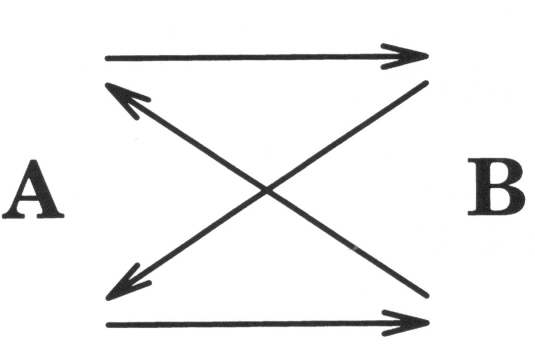
Figure 1. |
|
Figure 2. |
Page 42 Fall 1995
|
Silly But Fun Passing Patterns
Here
are some fun passing patterns. Some of you may find
Odd
1-Count Bounce Passing In
recent years, people have been doing more ball passing by bouncing
balls to their partners. The 1-count patterns with an odd number of
balls are particularly popular, as they avoid any question of whether
or not to bounce the self and allow all the throws to take equal
amounts of time. With the relatively long time between the throw and
catch of a bounced ball, bounce passing makes it possible to pass more
balls with less physical effort (except when chasing stray balls) than
you might be able to in the air. Each toss only goes a few inches
above the throwing hand and then falls, only to bounce up to the other
person, who catches it on the way up. (This is the "lift"
bounce.)
Now
odd 1-counts, whether
You
can bounce pass a mere 5 balls this way, in a very slow pattern. You
can, however, throw sooner than you have to and thus speed up the
pattern to make it a little more interesting. If you throw each ball
as soon as you get it, you might find the 5-ball pattern feels more
like a 13-ball pattern.
Of
course, you can also bounce pass 7, 9, 11, 13 or more balls in exactly
the same way, except that the pattern speeds up as you add balls.
Start with a small number and see how many you can work up to or how
fast you can go by throwing before you need to.
Most bounce passers stand something like 5 or 6 feet apart, but experiment with different distances. You may find it fun to stand a long way apart and let the balls bounce more than once, for instance. Or see how close you can stand and still bounce the balls between you.
Odd
1-Count Half-Bounce Passing What's
a half-bounce, you say? Good question. This pattern is a hybrid
between passing entirely in the air and entirely by bouncing. Stephane
Saux and I have played around with this pattern with an odd number of
balls recently at the San Francisco jugglers meeting.
As
in the Odd 1-Count Bounce Passing described above, one person throws
straight and one diagonally (Fig. 1). But one juggler bounces the
passes from both hands to the other person, while the second juggler
passes from both hands without bouncing, throwing the balls up nice
and high. It's probably a little easier if the bounces are thrown
diagonally, but try out the other version with the bounces going
straight. Of course each of you will want to try throwing the bounces
as well as the high throws. The half-bounce start is just as
described above in odd 1-count ball bouncing.
An
interesting effect in this half-bounce pattern is that the bouncer has
to look up to see incoming high throws, but the high-pass thrower has
to look down to see incoming bouncing balls. This makes it difficult
to see where your own passes are going. Nevertheless I found that if
you're the bouncer, you can see your outgoing passes a little if you
try to keep your focus from going up too high. This is helpful for
keeping the throws under control.
There is a tendency here for the nonbounce passer to make throws that are too low,
since that juggler is looking down at balls bouncing up. So make sure
the non-bounced passes are thrown reasonably high, higher than it
feels like they should be. The speed of this pattern is largely
determined by the height of those high throws, so if they are low,
you'll end up having to juggle noticeably faster. This should be no
surprise.
If
you're really adventurous, instead of having all the bounce throws
coming from one person, you could have each person throwing bounce
passes with one hand and non-bounce passes with the other. This ought
to be thoroughly confusing, silly and lots of fun, if not impossible
because of having to look alternately up for high passes and down for
bounce passes.
Now on to some club passing patterns.
3-Count
Double Line This
is a relatively simple four person line
Each
person passes a 3-count with the second person to the front. That is,
in Fig. 2, jugglers A and C are passing with each other, as are Band
D. Everyone has to pass around someone (either B or C). The two
separate |

Figure 1. |
|
Figure 2. |